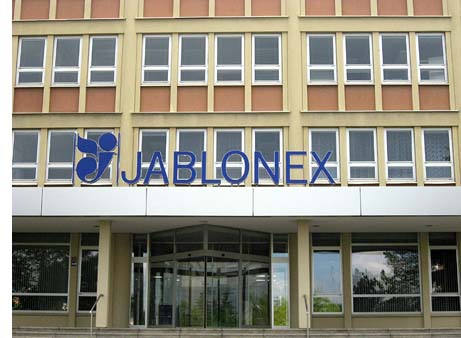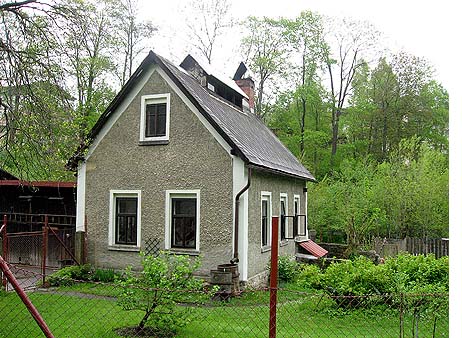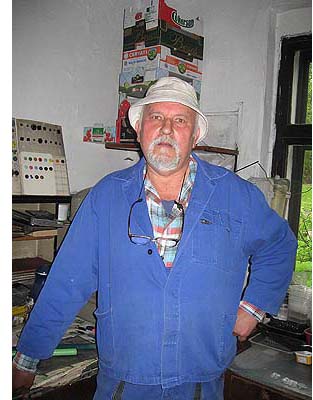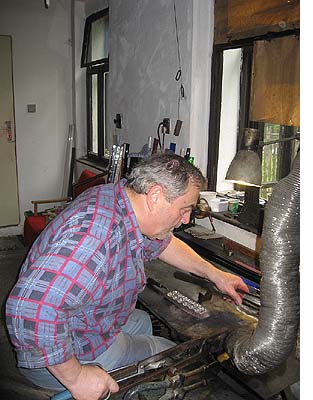|
Czech
Button Industry - 2010
2050 - Remember that year; write it down, underline it. This
could be the year the Czech glass button disappears forever!
Or at least new glass button production. Existing stock and
vintage glass buttons will be around for quite some time after
that date, but this is the estimate I have come up with for the
death of this industry . . . That is only 40 years away.
Here is the reason why. Jablonec nad Nisou, Czech Republic,
is the center for production of glass beads and buttons in Europe.
Since the 14th century when King Charles of Bohemia invited German
glass makers from the Rhineland/Black Forest area of Germany
to settle in the forests of Northern Bohemia to centralize the
production of glass for his strong Empire of Bohemia, bead and
button making has dominated this region; and made Northern Bohemia
famous for its unique and beautiful jewelry and button manufacture,
as well as crystal vases, sculptures and chandeliers.
 Every generation since then, strong,
dominating families specializing in glass manufacture rose to
power, left their imprint on the glass world, then fell, making
way for the next generation. In the 1800's it was the Riedl family.
In the 1900's until 2009, it was the state run monopoly of Jablonex
that manufactured and controlled the glass works of Jablonec
nad Nisou. As of 2010, Preciosa, the giant crystal chandelier
company, purchased Jablonex and now controls the glass works
going into the future. Every generation since then, strong,
dominating families specializing in glass manufacture rose to
power, left their imprint on the glass world, then fell, making
way for the next generation. In the 1800's it was the Riedl family.
In the 1900's until 2009, it was the state run monopoly of Jablonex
that manufactured and controlled the glass works of Jablonec
nad Nisou. As of 2010, Preciosa, the giant crystal chandelier
company, purchased Jablonex and now controls the glass works
going into the future.
Within this framework of glass manufacture, small cottage
industries of bead and button makers arose. Prior to 1732, lampwork
was the sole method of button and bead making. But in that year
the first button mold was invented and used to make pressed buttons,
with metal shanks inserted into the pliers and then glass pressed
into the mold so that the shank was incorporated into the button
at the same time. This revolutionized the button industry. In
comparison, the first bead mold was only introduced into the
manufacture of pressed glass beads in 1832 at the Prague Trade
show, 100 years later.
By 1890 there were over 2000 agents and manufactures of beads
and buttons in Gablonz, (the name the Germans called Jablonec
nad Nisou). Gablonz, Bohemia was synonomous with high quality
crystal and glass production of vases, beads, buttons and chandeliers.
Names like Strauss and Swarovski were known world wide.
1914 was the start of World War I, and at the end of the war,
1918, the Austrian Empire had collasped. Vienna was no longer
the capital of the world, and Bohemia was just a province of
a new country that rose out of the ashes; Czechoslovakia.
Gablonz was still the glass bead and button center, with German
ownership of the factories and Czech workers manning the machinery.
During World War II Bohemia was annexed by Hitler's Germany,
as Sudutenland, and the Suduten Deutsh (Germans) were returned
to the fold after eleven centuries of foreign citizenship. However,
not only were most glass beads, buttons and raw glass not produced
during the war because industry was geared towards war production;
but the Germans lost the war and the Suduten Deutsh were deported
en masse back to Germany, leaving behind their homes, their business's
and factories. Their creative skills and energy needed to continue
making beads and buttons was lost, and although the gap was filled
by the Czech workers who took over the industry, any creativity
was stifled by the communists who ruled post war Czechoslavakia,
and literally stomped out by the Russian invasion of 1968.
By 1989 there were only 2 button factories left operating.
The 1989 Velvet Revolution threw off the Communist shackles,
and some new blood flowed through the veins of the glass industry,
and glass bead factories opened up all over town. Unfortunately,
the same thing did not happen to the glass button industry.
 There was only one hand over to
new ownership of the oldest button factory in Jablonec; and that
was to Tomas of H-Glass. Along with his purchase came the buildings
(in crumbling decay), the button molds and pliers (over 40,000),
ovens, grinders, tools and inventory. Prior to the purchase by
Tomas, the factory was called H and J Glass, and the owner was
Jalgo Shrimer of Jalgo V.O.S. in Kokonin. When Thomas bought
the business he dropped the J. There was only one hand over to
new ownership of the oldest button factory in Jablonec; and that
was to Tomas of H-Glass. Along with his purchase came the buildings
(in crumbling decay), the button molds and pliers (over 40,000),
ovens, grinders, tools and inventory. Prior to the purchase by
Tomas, the factory was called H and J Glass, and the owner was
Jalgo Shrimer of Jalgo V.O.S. in Kokonin. When Thomas bought
the business he dropped the J.
The other button factory is Elegant, which was founded in
1918 in Smrzovka, a small village just outside of Jablonec. The
present owner purchased it in 1997 from Skelena Bizuterie, before
Jerry Starman owned Skelena Bizuterie. Before that it was called
Elegant. The present owner restored the original name to the
factory. In the 1970's Elegant employed 32 button pressers, mainly
for the Russian market. According to the present owner, the Russians
never paid for any of their buttons. The factory was state run
at that time.
 We personally know of a third
button maker who operates a small cottage industry factory that
he inherited from his grandfather. His grandfather and father
operated the factory until the communists arrested them for unpatriotic
behaviour and enslaved them in a gulag for many years. When we
met Josef in 2005, he was just opening a little crystal factory
shop, but had all the tools of the trade to make buttons - which
he does for us exclusively. So if we know of a small button maker
with approximately 400 molds, then there must be several others
who also make small quantities for exclusive customers that we
don't know. We personally know of a third
button maker who operates a small cottage industry factory that
he inherited from his grandfather. His grandfather and father
operated the factory until the communists arrested them for unpatriotic
behaviour and enslaved them in a gulag for many years. When we
met Josef in 2005, he was just opening a little crystal factory
shop, but had all the tools of the trade to make buttons - which
he does for us exclusively. So if we know of a small button maker
with approximately 400 molds, then there must be several others
who also make small quantities for exclusive customers that we
don't know.
Except for Tomas of H-Glass, who is in his 30's, there are
only 2 pressers at Elegant - brothers from a family of button
pressers. They are in their 60's. Joseph is in his 50's. The
pressers at H Glass are all in their 60's.
None of the owners of those two factories nor Josef can find
a young worker or apprentice to learn the presser business and
therefore continue the pressing of glass buttons. None of the
existing button pressers have children willing to learn or take
over the business from their parents, as has been done for generation
after generation. Most all of the young people want to get into
white collar jobs and careers involving computers.
 So in about 40 years from now
the only button pressers in Jablonec and surrounding areas today
(which number around 10 older men) will be either dead or too
old to work. There will be no - one to take their place or interested
to learn a business which involves making buttons, and so the
industry will die a natural death. So in about 40 years from now
the only button pressers in Jablonec and surrounding areas today
(which number around 10 older men) will be either dead or too
old to work. There will be no - one to take their place or interested
to learn a business which involves making buttons, and so the
industry will die a natural death.
We feel very honored to be involved in this button industry
and to have met all the button makers while this art of button
making is still alive. Also note: while there are glass bead
making schools in Zelezny Brod and the Jablonec area, none teach
glass button making.
We were lucky enough to interview two button pressers who
work for Elegant and H-Glass:
Clement Riedl is 62 years old and started pressing at age
15. He followed his family into the glass business, but whereas
they went into bead pressing, he went into button pressing. Jaroslav
Lipsky is 64 years old and started pressing buttons at age 14.
Between the two of them they estimate they have pressed 40,000,000
buttons in 50 years.
We asked both owners what their plans are to prevent the demise
of this business and they both just shrug and say nothing . .
. They have no solutions . . . This art will die.
Guy and J-Me own Wild Things Beads and can be reached by phone
at 530-743-1339 or on the web at wildthingsbeads.com.
They import glass beads and buttons from Czech Republic, as well
as lead tours to bead regions around the world in an effort to
promote bead knowledge, history and commerce.
   |